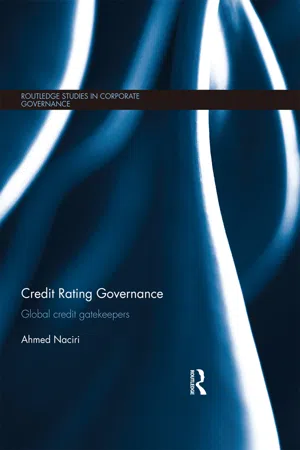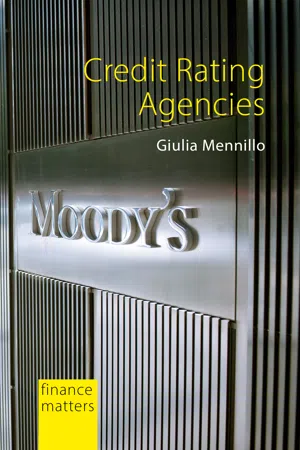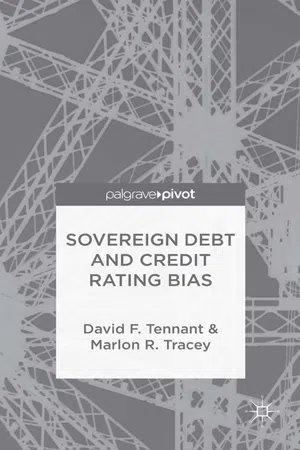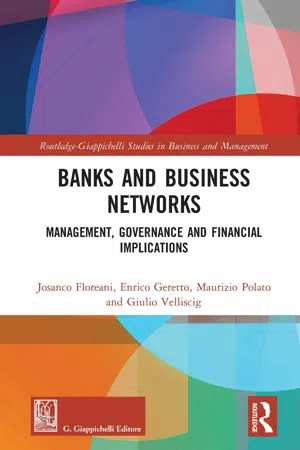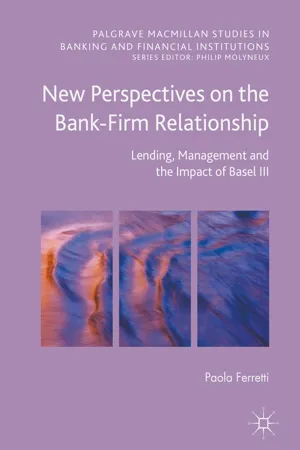Economics
Credit Ratings
Credit ratings are assessments of the creditworthiness of individuals, companies, or governments. They are assigned by credit rating agencies based on the entity's ability to meet its financial obligations. Ratings typically range from AAA (highest) to D (default), with higher ratings indicating lower credit risk. These ratings are important for investors and lenders in evaluating the risk associated with providing credit or investing in a particular entity.
Written by Perlego with AI-assistance
8 Key excerpts on "Credit Ratings"
Learn about this page
Index pages curate the most relevant extracts from our library of academic textbooks. They’ve been created using an in-house natural language model (NLM), each adding context and meaning to key research topics.
- eBook - ePub
Credit Rating Governance
Global Credit Gatekeepers
- Ahmed Naciri(Author)
- 2015(Publication Date)
- Routledge(Publisher)
1 Introduction to the world of credit rating DOI: 10.4324/9781315757834-1A credit rating (CR) is meant to be an opinion on the creditworthiness of an issuing entity (e.g. an issuer of bonds or a contractor of debt), on a debt instrument (e.g. bonds, loans or asset-backed securities)1 or, for some agencies, on the financial strength of an insurer (for life and property-casualty insurers). Credit Ratings may allow uninformed investors to quickly assess the broad risk properties of tens of thousands of individual securities using a single and well-known scale (Becker and Milbourn, 2009 ). Credit Ratings also can play much more fundamental roles in enhancing market efficiency: (i) they can, for instance, reduce information asymmetries by providing information on the rated security. (ii) They can contribute to solve certain principal–agent problems, such as fixing the level of risk that an agent can take on behalf of his principal. (iii) ‘They can solve collective action problems of dispersed debt investors by helping them to monitor performance, with downgrades serving as a signal to take action’ (World Bank, 2009 ). Credit Ratings are supposed to be based on formal, as well as rational, activity and presented according to an agreed ranking system or scale in the form of ‘AAA’, ‘AA’, ‘A’ to ‘CCC’. Till the 1980s, the demand for Credit Ratings was not substantial, economic entities were still filling most of their financial needs by resourcing to banks and credit unions, and endeavouring to concentrate on things in which they were feeling to have advanced knowledge and intimate confidence. From the 1980s onwards, however, as the financial system became more and more deregulated and an enforcement mechanism reduced, companies started increasingly borrowing from the globalized debt markets, and consequently Credit Ratings agencies became more and more relevant and valuable (Kingsley, 2012 - eBook - ePub
- Craig E. Carroll(Author)
- 2016(Publication Date)
- SAGE Publications, Inc(Publisher)
Pierre Pénet Pierre Pénet Pénet, PierreCredit Rating Credit rating235 239Credit Rating
A credit rating is an assessment published by a credit rating agency of the creditworthiness of a financial entity (issuer rating) or a particular financial instrument (issue rating). Users of Credit Ratings typically include institutional and individual investors, lenders, and public regulators. Credit Ratings are not to be confused with credit scores assigned by consumer reporting agencies to represent the creditworthiness of individual consumers. Credit rating agencies assign Credit Ratings to private entities (corporations and financial institutions) and public entities (municipalities, states, sovereign governments, and supranational entities) operating domestically or internationally. Rated instruments include, among other things, bonds, commercial paper, bank deposits, loans, and structured debt instruments.The value added of credit rating agencies is to produce independent credit analysis. Credit Ratings are calculated as the likelihood of a default occurring over a short-term or long-term period, and they are expressed as alphanumerical grades on an ordinal scale. The rating scales used by major credit rating agencies display rating grades in inverse order of default likelihood, from lowest (“AAA”) to highest (“C” or “D” according to the rating nomenclature) (see Table 1 ).Table 1Since their emergence in the early 20th century in the United States, Credit Ratings have spread internationally to every corner of the financial world to become pivotal reputational intermediaries for private and public (including sovereign) financial entities. This entry first gives a brief history of Credit Ratings since they originated in the United States in the early 20th century. It then discusses rating methodologies and credit rating agencies’ business models. Finally, it examines the significance of ratings in regulatory frameworks. - eBook - ePub
- Moorad Choudhry(Author)
- 2010(Publication Date)
- Wiley(Publisher)
Fitch) also has a high profile.The specific factors that are considered by a ratings agency, and the methodology used in conducting the analysis, differ slightly amongst the individual ratings agencies. Although in many cases the ratings assigned to a particular issue by different agencies are the same, they occasionally differ, and in these instances investors usually seek to determine what aspect of an issuer is given more weight in an analysis by which individual agency. Note that a credit rating is not a recommendation to buy (or, equally, sell) a particular bond, nor is it a comment on market expectations. Credit analysis does take into account general market and economic conditions; the overall purpose of credit analysis is to consider the financial health of the issuer and its ability to meet the obligations of the specific issue being rated. Credit Ratings play a large part in the decision-making of investors, and also have a significant impact on the interest rates payable by borrowers.Credit Ratings
A credit rating is a formal opinion given by a rating agency, of the credit risk for investors in a particular issue of debt securities. Ratings are given to public issues of debt securities by any type of entity, including governments, banks and corporates. They are also given to short-term debt such as commercial paper as well as bonds and medium-term notes.Purpose of Credit Ratings
Investors in securities accept the risk that the issuer will default on coupon payments or fail to repay the principal in full on the maturity date. Generally, credit risk is greater for securities with a long maturity, as there is a longer period for the issuer potentially to default. For example, if a company issues 10-year bonds, investors cannot be certain that the company will still exist in 10 years’ time. It may have failed and gone into liquidation some time before that. That said, there is also risk attached to short-dated debt securities; indeed, there have been instances of default by issuers of commercial paper, which is a very short-term instrument. - eBook - ePub
- Giulia Mennillo(Author)
- 2022(Publication Date)
- Agenda Publishing(Publisher)
2 What do credit rating agencies do? The authors of the common language of credit riskA credit rating agency rates the creditworthiness of a bond issuer. But what does this actually mean? Common knowledge in the context of financial markets suggests that rating involves an assessment of creditworthiness, which relies on figures and data conventionally deemed relevant for this purpose. Generally speaking, the verb “to rate” signifies the assignment of “a standard or value to (something) according to a particular scale”.1 In the case of credit rating, the object of the assessment refers to any entity seeking access to capital markets by issuing bonds to satisfy its funding needs, ranging from companies, banks, municipalities and sovereigns to supranationals.2 In the case of public entities, the refinancing through capital markets is not as apolitical as it sounds. When a state or municipality resorts to capital markets, it exposes itself to the CRAs’ judgement, becoming subject to the logics and interpretive frameworks of the financial market community. Unlike politically unpopular taxation, a public entity implicitly consents to the rules of the game of the financial market’s sphere. Apart from creating a financial dependence, the borrower tacitly accepts that norms, worldviews and ideas preponderant in financial markets transcend and diffuse into the political sphere.Considering the definition of the verb “to rate” – assigning a standard or value to a particular scale – the specificity of the credit rating scale is that it is created by the CRAs themselves. The same applies to the assigned value – that is, the rating content; scale and value do not exist independently from each other. The scale constitutes the rating content, mirroring how creditworthiness has come to mean “credit rating”. Instead of amounting to a quasi-metric that is fungible and transferable to other units of measurement, Credit Ratings have gained power of definition over creditworthiness: A bond issuer is deemed creditworthy because - eBook - ePub
- D. Tennant, M. Tracey(Authors)
- 2017(Publication Date)
- Palgrave Pivot(Publisher)
These questions are of concern not only to the borrowers, but naturally to the creditors as well. Investors face the complex task of assessing the creditworthiness of sovereign debt issues in an environment characterized by increased uncertainty in the post-global crisis era. Even without the heightened uncertainty, the complexity of assessing the creditworthiness of sovereign debt should not be underestimated. This is because a country’s ability and willingness to repay debt is affected not only by its economic, social and political dynamics, but also by increasingly commonplace internal and external shocks.How do creditors make their decisions as to a country’s creditworthiness? Increasingly they have come to rely on the assessments provided by credit rating agencies (CRAs). CRAs garner information on borrowers from a variety of sources and assess the default risk of the financial products being offered. The default risk is computed and condensed into a single relative measure—a credit rating in the form of a letter grade (Kruck 2011). This rating is a judgment on the “future ability and willingness of an issuer to make timely payments of principal and interest on a security over the life of the instrument.”2 This judgment forms the basis of the important but often uneasy relationship between countries which rely on funds from international capital markets, and the CRAs which influence the countries’ ability to access such funds.Gatekeepers to the international capital marketsThe CRAs’ outputs are used to guide the investment choices of government agencies and key institutional investors in the capital markets (pension funds, investment banks and other financial institutions). At the start of the millennium, the two major CRAs (Moody’s and S&P) passed judgment on approximately US$30 trillion worth of securities each year. According to their own estimates, at that time Moody’s had 4,000 clients for its publications and approximately 30,000 regular readers of its print output, and both Moody’s and S&P regularly issued press statements about credit conditions (Sinclair 2005). Output produced for dissemination through the Internet was just then gaining popularity. By the end of the 2007–2009 global crisis, however, CRAs have become known to even the casual newspaper reader. This is not only because of the plethora of articles that have blamed the CRAs for several failures leading up to and exacerbating the crisis, but also because of the demonstration of the critical role that the CRAs play in global investment decisions (Kruck 2011). - eBook - ePub
Banks and Business Networks
Management, Governance and Financial Implications
- Josanco Floreani, Enrico Geretto, Maurizio Polato, Giulio Velliscig(Authors)
- 2022(Publication Date)
- Routledge(Publisher)
The elements generally taken into account for defining the ratings to be attributed to the other parties, for internal use, i.e., for current management purposes, can be identified as the following 2 : 2 No reference is made in this discussion to the provisions on the subject arising from the supervisory regulations of banks. Measurements derived from scoring systems based on the reading of particular economic-financial indicators calculated from balance-sheet figures. Assessments concerning the current and prospective conditions of the sector to which the enterprise belongs. The examination of variables of a qualitative nature, such as the governance features, the professional profile of the management, the competitive position on the markets of interest, etc. Analyses of a performance type and related to the existing relationship with the particular bank or with the entire credit system (so-called public and/or consortium central credit registers). These components are integrated, in order to determine the rating, according to different kinds of criteria ranging from statistical processing, with assignment of a particular weight to each of them, to subjective evaluation mechanisms based on judgments formulated by experts. It should be noted that in practice, intermediate solutions are sometimes used: on the basis of quantitative data alone, a first “partial” rating is derived, to be subsequently integrated with information of a qualitative nature. The measurement of credit risk, in general terms, takes place according to two distinct approaches defined as “model based” (and differentiated into structural models and in reduced form models) and as “traditional” (or “non-model based”, as they are based on historical data about insolvencies) (Cherubini et al., 2004 ; Chatteryee, 2015) - eBook - ePub
The Economy of Promises
Trust, Power, and Credit in America
- Bruce G. Carruthers(Author)
- 2022(Publication Date)
- Princeton University Press(Publisher)
111The pace of change continued after the Great Depression, when official regulatory status was granted to Credit Ratings, and following World War II, with the vast expansion of U.S. industrial capacity and growth of a consumer economy. On the regulatory side, bond ratings continued to gain importance.112 In 1951, the National Association of Insurance Commissioners (NAIC) used ratings to create uniform asset categories for insurance companies,113 and ratings remain important in insurance regulation.114 In 1975, the Securities and Exchange Commission began to use ratings to set net capital rules for broker-dealers and created a new official category, Nationally Recognized Statistical Rating Organizations (NRSRO), with which to designate the most important rating agencies.115 Then, at the international level, ratings became part of the Basel II Bank Capital Standards as a way to set the “risk weights” given to bank assets. And ratings gained even more global importance when they were incorporated into the contractual language that supported the over-the-counter (OTC) financial derivatives market. Unlike the standardized derivatives traded on exchanges, OTC derivatives are customized, usually in order to “hedge” a very particular risk faced by the client (e.g., the possibility that future income denominated in a foreign currency might suddenly drop in value). Transactions are usually specified on the basis of a master agreement between a dealer-bank and its client, building on standardized contractual language designed by the International Swaps and Derivatives Association.116 Starting in the 1990s, ratings were used to measure and mitigate “counterparty risk” for various kinds of swaps. This risk arose from the possibility that the other party to a transaction might not be able to fulfill its contractual obligation, and like the old-fashioned mortgage, risk was managed through collateral. In the “credit support annex” attached to the master agreement, Credit Ratings were used to estimate the magnitude of “counterparty risk,” to set the amount of collateral, and to value the collateral itself.117 So, for example, if a rating agency lowered the ratings of a party to a swap, that party would be contractually required to post more collateral. The general point is that Credit Ratings have been built right into the basic contractual “machinery” of the international OTC derivatives market, that they were adopted by global financial regulators, and that ratings retained their contractual and regulatory significance even after the global financial crisis of 2008.118 - eBook - ePub
New Perspectives on the Bank-Firm Relationship
Lending, Management and the Impact of Basel III
- Paola Ferretti(Author)
- 2016(Publication Date)
- Palgrave Macmillan(Publisher)
Therefore it is important in such a setting to understand the important role internal ratings play in credit decisions, pricing and risk measurement and management for internal purposes. It is also relevant to analyse to what extent the credit process can be impacted by the use of such methods, considered in a setting other than the supervisory one.The essence of the functioning of internal ratings can be found in the transition from traditional investigation—potentially biased by the analyst’s personal judgements—to a more complex information processing. More specifically, the rating system identifies all structured and documented methodologies, organizational processes and control, and methods of database organization that enables the collection and processing of relevant information for the formulation of the synthetic risk assessment of a counterparty or individual lending operation. Through the rating system, the bank assigns the debtor an internal degree of creditworthiness (rating), ordering the counterparties in relation to their risk profile, and then estimates the credit risk components. The rating thus consists of assessing, in a given time interval, all reasonably available quantitative and qualitative information, and expressing through a classification of the ordinal scale, the debtor’s ability to meet contractual obligations. Each rating class is associated with a Pd. Basically the goal is to obtain an indicator that allows a graded level of risk associated with each business. The individual probabilities of default are then placed in an appropriate range of values (master scale), sometimes corresponding to those used by the official rating agencies to allow uniformity between internal and external ratings (Birindelli and Ferretti 2010 ).This is also the scope of the statistical estimating methods for expected insolvency of the borrowing rate, known as the scoring models (among others, De Laurentis and Maino 2009
